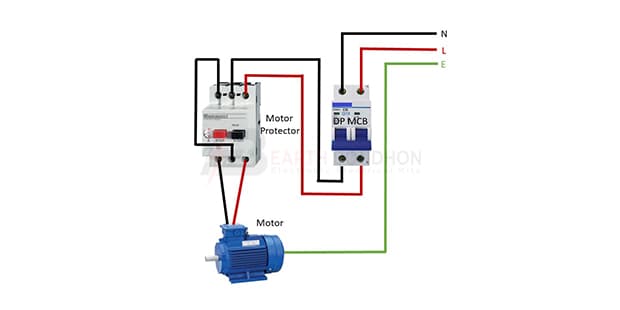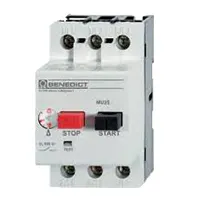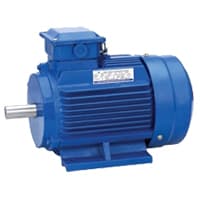Motor With Motor Protector Wiring:
This diagram shows how a motor with motor protector wiring can be made. In this circuit, we use a single-phase motor, a DP MCB ( Double Pole Miniature Circuit Breaker), and a motor protector device. First, we need to connect the DP MCB with the power source. Then connect the motor protector and motor with the MCB. Now this circuit is ready for use. This circuit is very simple and easy to make. If you want to know more about this circuit please check our youtube video below the post.
Advertisements
Components needed For this Project:
You can get the components from any of the sites below:
- MPCB Switch [See Buy Click Amazon]
- DP MCB 16A [See Buy Click Amazon]
- Single Phase Motor (1 HP) [See Buy Click Amazon]
*Please note: These are affiliate links. I may make a commission if you buy the components through these links. I would appreciate your support in this way!
Advertisements
Components used to make the Motor With Motor Protector Wiring:
MPCB = Motor Protection Circuit Breakers. A protection system against electrical faults, such as short circuits for AC Line 220V. line-to-ground faults, and line-to-line faults. Electrical faults that are below the MPCB is breaking capacity can be interrupted by the board.MCBs are designed for a wide variety of functions circuit protection functions while MPCBs are used for the specific function of protecting circuits driving electric motors.
02. DP MCB:
DP MCB In 2 Pole MCB, switching & protection is affected in phases and the neutral. A Double Pole or DP Switch is a Switch that Controls 2 Circuits at the same time. In terms of Residential Switching, this Normally means it Switches the live and Neutral at the same time. In Layperson Terms, Double Pole switches or DP Switches are Exclusively Designed to Control 2 Different Electrical Circuits at the same time, which allows the Appliances to Isolate safely and reliably. Fan or light Combinations and Medical Equipment are some of the many applications for DP Electrical Switches and Electrical components.
A Single-Phase Motor is an Electrically-Powered Rotary Machine That Can Turn Electric Energy into Mechanical Energy. It Works by Using a Single-Phase Power Supply. Single-phase Motors Are Used in Equipment And Machines That Are Smaller in Size And Require Lower Horsepower. This Includes Equipment Such As Refrigerators, Pumps, Compressors, Fans, and Portable Drills. Single-phase motors Have a Similar Construction to The 3-phase Motor, Including an AC Winding That is Placed on The Stator And Short-Circuited Conductors That are Placed in a Cylindrical Rotor.
Thank You for visiting the website. Keep visiting for more Updates.
Frequently asked questions
typically, a circuit diagram breaker is ahead of the contactor, and an overload is attached or directly behind a contactor/motor starter in the circuit. Motor protector circuit breakers are available that cover the CB/fuse and motor overload needs in one convenient device.
Overload protection relays prevent motor damage by monitoring the current flow in the motor circuit and breaking the circuit when an electrical overload or a phase failure is detected. Since relays are much cheaper than motors they provide an affordable way of protecting of the motors.
Motor overload occurs when a motor is under an excessive load. The primary symptoms that accompany a motor overload are excessive current draw, insufficient torque, or overheating. Excessive pump heat is a major cause of motor failure.
The overload of a 3-phase asynchronous motor means that the current flowing through the motor exceeds the rated current flow within a certain allowable time.
Starters - Most electric motor starters have an overload of protection built in in the form of an overload relay. When an overload situation occurs, the starter trips and the power supply is removed from the circuit. Starters are great for motors that only require start or stop control, but not speed control.
Read more Single Phase Wiring
What is a kilowatt-hour (kWh) | kwh formula | What does kwh mean
Introduction to Electrical Units and CircuitskW and kWh on your electricity bill As your home uses electricity during...
What is the Difference Between kVA | What does KVA mean | kVA formula
Difference Between KVA ExplainedWhat does KVA Mean? There are technical terms aplenty when it comes to generators, and...
Power Factor | Power Unit | Energy | Electricity Unit
Power factor definition | Calculating Power FactorPower Factor Values In a purely resistive circuit, the power factor...




0 Comments